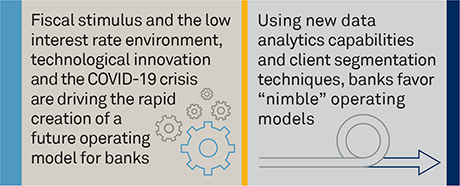
Record low interest rates and a pandemic that shut down the global economy have pushed the wholesale banking industry into innovation overdrive. At the current pace of change, the operating model for corporate and transaction banking is likely to be entirely transformed in the next three to five years.
In this report, we examine the forces driving this rapid evolution and identify the defining characteristics of the new operating model emerging from these changes.
That “Future Operating Model” will be digital, nimble and open.
![]()
Digitization/Digitalization. In the span of just a few months, the COVID-19 crisis swept away most hesitations among corporate clients about using online tools, as well as any inertia remaining in the industry about the switch to digital. This sudden shift has given banks leeway to expand the use of digital channels and tools to reduce costs-to-serve.
![]()
Agile/Nimble. Using new data analytics capabilities and client segmentation techniques, banks are attempting to leave behind one-size-fits-all approaches in favor of “nimble” operating models that calibrate service levels and channels to meet the needs of clients in the most efficient way possible and at the lowest possible cost-to-serve.
![]()
Open. Perhaps the biggest change will be the transformation of the bank operating model from a closed system to open architecture. The development of application programming interfaces (APIs), the cloud and software as a service (SaaS) are eliminating the high switching costs that, to this point, have defined both client relationships and bank business strategies.

